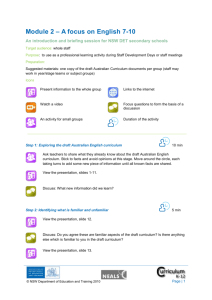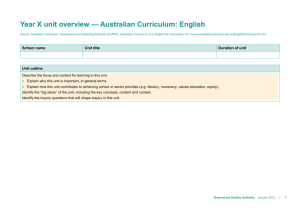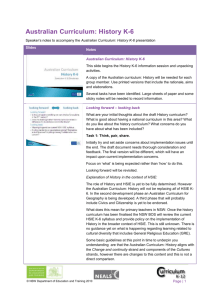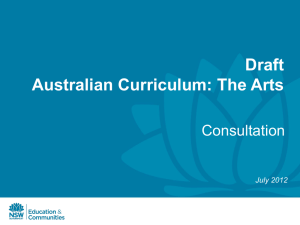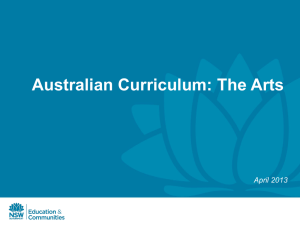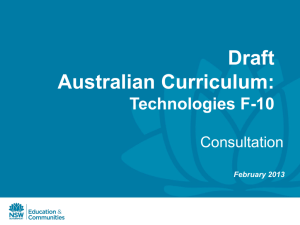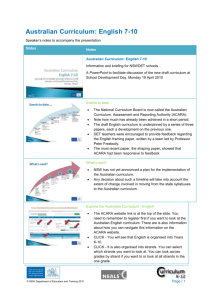Australian Curriculum: Science 7-10
advertisement
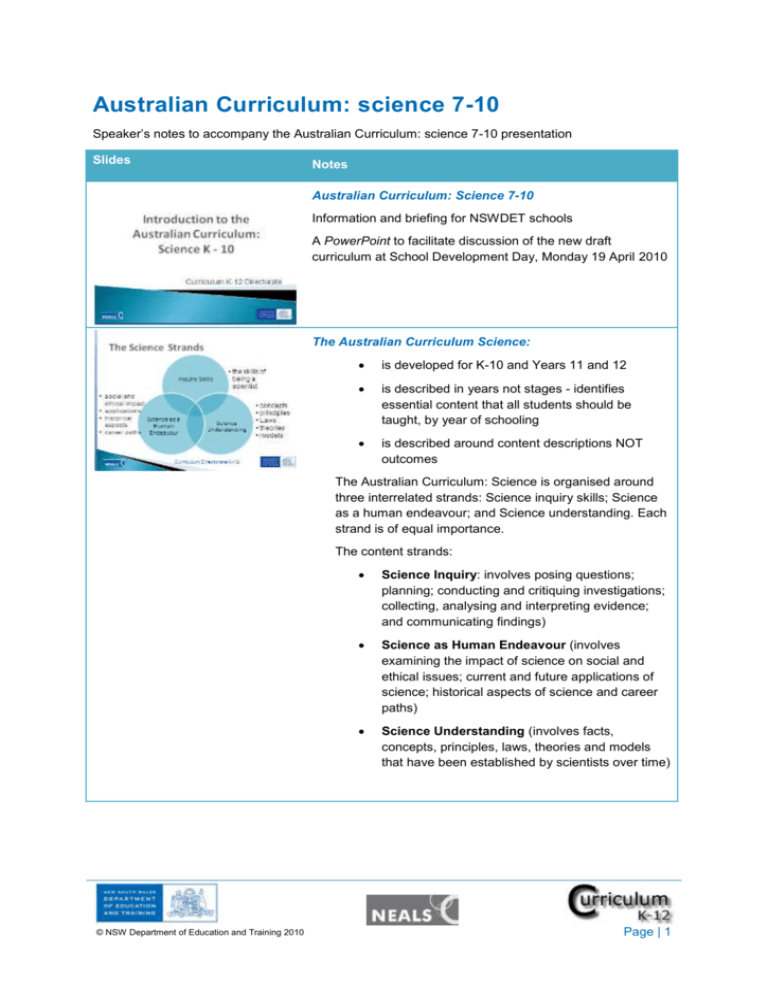
Australian Curriculum: science 7-10 Speaker’s notes to accompany the Australian Curriculum: science 7-10 presentation Slides Notes Australian Curriculum: Science 7-10 Information and briefing for NSWDET schools A PowerPoint to facilitate discussion of the new draft curriculum at School Development Day, Monday 19 April 2010 The Australian Curriculum Science: is developed for K-10 and Years 11 and 12 is described in years not stages - identifies essential content that all students should be taught, by year of schooling is described around content descriptions NOT outcomes The Australian Curriculum: Science is organised around three interrelated strands: Science inquiry skills; Science as a human endeavour; and Science understanding. Each strand is of equal importance. The content strands: © NSW Department of Education and Training 2010 Science Inquiry: involves posing questions; planning; conducting and critiquing investigations; collecting, analysing and interpreting evidence; and communicating findings) Science as Human Endeavour (involves examining the impact of science on social and ethical issues; current and future applications of science; historical aspects of science and career paths) Science Understanding (involves facts, concepts, principles, laws, theories and models that have been established by scientists over time) Page | 1 What’s the organisation? Curriculum is organised year by year with achievement standards for each year of schooling. Content descriptions are supported by content elaborations to clarify meaning. Achievement standards are supported with work samples to clarify standards. Explore the Australian Curriculum – Science Content descriptions The Australian Curriculum for Science is organised with explicit descriptions of what is to be taught to students and what is expected of their learning at every year of schooling. The Australian Curriculum identifies essential content that all students should be taught and ensures that there is time to pursue deep learning of that content. The Australian Curriculum also allows flexibility for schools and teachers to include local and topical content. The content descriptions provide a well-researched scope and sequence of teaching, within which teachers will determine how best to cater for individual student's learning needs and interests. Teachers, however, will decide how best to organise learning, the contexts for learning and the depth of learning that will be pursued for each child in their class. Teachers will use the Australian Curriculum to identify the most appropriate content (possibly from across several year levels) to teach individual and/or groups of students. This will take account of the fact that in each class there will be a range of prior achievement (below, at and above the year level expectations) and that teachers will plan to build on current learning. Exploring the content descriptions © NSW Department of Education and Training 2010 Choose a year (and consider a cohort of students). Look at the strands, content, content elaboration and achievement standards. Are they in line with your expectations of this stage of development? Choose a strand and then look across year levels. Is there continuity? Page | 2 The content elaborations An example of the content descriptions with supporting elaborations. Note that the content elaborations are not mandatory content. Evaluating the content elaborations Discuss the questions as a faculty. List the benefits and negative aspects of having the content elaborations. How would you use content elaborations? Do they clarify the content intent without adding new content? Are content elaborations valuable? For programming? For building a continuum of learning? For developing an understanding of the Australian Curriculum: Science? Achievement standards © NSW Department of Education and Training 2010 Teachers can use the achievement standards to assist them as they plan and review teaching programs, and at the end of a period of teaching to make judgments about the quality of learning demonstrated by the students. The achievement standards will help teachers make decisions about the content of their teaching programs and the strategies that they will use. They will guide teachers on what is expected of students each year and aid them to think about where their students are ‘at,’ where they need to progress to, and to eventually judge how well they have achieved. Page | 3 Evaluating the achievement standards Discuss as a faculty the Achievement standards year by year. Do they resonate with your current students capabilities at the end of each year of schooling? Would they describe a typical student who would be awarded a C grade? Is the standard expected higher, lower or similar to the standards set by you and the science faculty now for students at that age group? Discuss: How will you use the achievement standards? Are they of benefit in planning your teaching and learning programme? Do these standards reflect the important aspects of a students learning (content descriptions) in each year? Are they a useful guide to assist teachers in understanding the Australian Curriculum Science? Will they be something that assists teacher judgement of student performance? Will they help to build consistency of teacher judgement? Across NSW? Within the Region? Within the school? For individuals? Will the achievement standards aid your capacity to communicate with parents and the community? General capabilities and cross curriculum dimensions © NSW Department of Education and Training 2010 As a faculty review the 10 general capabilities and their suggested explicit inclusion in the learning using the filter capacity of the online draft Australian curriculum: science. Discuss the appropriateness of the suggested explicit teaching and learning outlined for the general capabilities. As a faculty review the explicit inclusion of aspects of the cross curriculum dimensions in the draft Australian curriculum: science. Discuss the appropriateness of the suggested explicit teaching and learning outlined for the cross curriculum Page | 4 dimensions Achievement standards This slide shows an example of achievement standards for Kindergarten. CLICK - The achievement standards are organised according to the modes. This is similar in design to the K-12 stage statements in the English 7-10 Syllabus. What is familiar? The content within the strand organisers in the Australian Curriculum align closely with the content in the current NSW Science Years 7-10 Syllabus. The organisation of knowledge and understanding content in Years will be welcomed by secondary science teachers in NSW. The organisation of Science as a Human Endeavour and Inquiry Skills into two year blocks will also be greatly welcomed in NSW – removing a great deal of uncertainty within schools and unnecessary variation in science programs across schools due to this uncertainty. There is more prescription in some Australian Curriculum: Science K-6 strands and less prescription in 7-10. The NSWDET consultation NSW DET through the “curriculumsupport” website, offers an opportunity to give your opinions, hear the opinions of others and inform the NSWDET position in an online forum environment. If an Internet connection is available review the website. To locate the site Google curriculumsupport and follow the links to the Australian Curriculum. Use a NSW DET email to join the forums Support and feedback at Curriculum K 12 Directorate © NSW Department of Education and Training 2010 Page | 5
